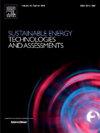Promoting bifunctional electrocatalytic activity and redox kinetics of praseodymium-based perovskite ceramic for electrochemical energy conversion and storage
IF 7.1
2区 工程技术
Q1 ENERGY & FUELS
Sustainable Energy Technologies and Assessments
Pub Date : 2024-11-04
DOI:10.1016/j.seta.2024.104067
引用次数: 0
Abstract
Praseodymium-based perovskites, like Pr0.4Sr0.6Ni0.2Fe0.7Mo0.1O3-δ (PSNFM), has excellent bifunctional electrocatalytic activity, making it suitable as a semiconductor material for reversible single-layer cell (RSLC) device, which can realize the electrochemical energy conversion and storage. To improve the electrocatalytic activity of PSNFM, Pr0.4Sr0.6Ni0.2Fe0.7Mo0.1F0.1O2.9-δ (F0.1-PSNFM), and (Pr0.4Sr0.6)0.95Ni0.2Fe0.7Mo0.1F0.1O2.9-δ (F0.1-(PS)0.95NFM) perovskite oxides are synthesized. In H2 atmosphere, it is found that NiFe10.8 alloy is deposited on the surface of reduced PSNFM and reduced F0.1-PSNFM, while NiFe alloy is deposited on the surface of reduced F0.1-(PS)0.95NFM, suggesting that the presence of A-site defects promoting the precipitation of metallic Ni. Moreover, the concentration of oxygen vacancies can be increased by both A-site defects and F- doping, which results from the reduction of average valence states of Ni, Fe, and Mo. This indicates that F0.1-(PS)0.95NFM has the highest number of oxygen vacancies serving as oxygen reduction reaction (ORR) sites and the reduced F0.1-(PS)0.95NFM exhibits the best hydrogen oxidation reaction (HOR) activity. For HOR, the rate-determining steps (RDS) on reduced PSNFM series semiconductor materials are charge transfer reaction and ORR process is controlled by a mixture of two elementary steps: the conversion of adsorbed oxygen to lattice oxygen and the reduction of O to O-. The combination of A-site defects and F- doping has been found to have a synergistic effect, leading to a significant enhancement of the discharge power density in single-layer fuel cell (SLFC) as well as the water electrolysis current density in single-layer electrolysis cell (SLEC).

促进镨基过氧化物陶瓷的双功能电催化活性和氧化还原动力学,用于电化学能量转换和存储
以Pr0.4Sr0.6Ni0.2Fe0.7Mo0.1O3-δ(PSNFM)为代表的镨系包晶石具有优异的双功能电催化活性,适合作为可逆单层电池(RSLC)器件的半导体材料,实现电化学能量的转换和存储。为了提高 PSNFM 的电催化活性,合成了 Pr0.4Sr0.6Ni0.2Fe0.7Mo0.1F0.1O2.9-δ (F0.1-PSNFM)和 (Pr0.4Sr0.6)0.95Ni0.2Fe0.7Mo0.1F0.1O2.9-δ (F0.1-(PS)0.95NFM)包晶氧化物。在 H2 气氛中,发现 NiFe10.8 合金沉积在还原型 PSNFM 和还原型 F0.1-PSNFM 的表面,而 NiFe 合金沉积在还原型 F0.1-(PS)0.95NFM 的表面,这表明 A 位缺陷的存在促进了金属镍的析出。此外,A-位缺陷和 F-掺杂都能增加氧空位的浓度,这是因为 Ni、Fe 和 Mo 的平均价态降低了。这表明 F0.1-(PS)0.95NFM 具有最多的氧空位作为氧还原反应(ORR)位点,而还原后的 F0.1-(PS)0.95NFM 具有最佳的氢氧化反应(HOR)活性。对于氢氧化反应,还原型 PSNFM 系列半导体材料的速率决定步骤(RDS)是电荷转移反应,而 ORR 过程则由两个基本步骤混合控制:吸附氧转化为晶格氧和 O 还原为 O-。研究发现,A-位缺陷与 F-掺杂的结合具有协同效应,可显著提高单层燃料电池(SLFC)的放电功率密度以及单层电解池(SLEC)的水电解电流密度。
本文章由计算机程序翻译,如有差异,请以英文原文为准。
求助全文
约1分钟内获得全文
求助全文
来源期刊

Sustainable Energy Technologies and Assessments
Energy-Renewable Energy, Sustainability and the Environment
CiteScore
12.70
自引率
12.50%
发文量
1091
期刊介绍:
Encouraging a transition to a sustainable energy future is imperative for our world. Technologies that enable this shift in various sectors like transportation, heating, and power systems are of utmost importance. Sustainable Energy Technologies and Assessments welcomes papers focusing on a range of aspects and levels of technological advancements in energy generation and utilization. The aim is to reduce the negative environmental impact associated with energy production and consumption, spanning from laboratory experiments to real-world applications in the commercial sector.
 求助内容:
求助内容: 应助结果提醒方式:
应助结果提醒方式:


